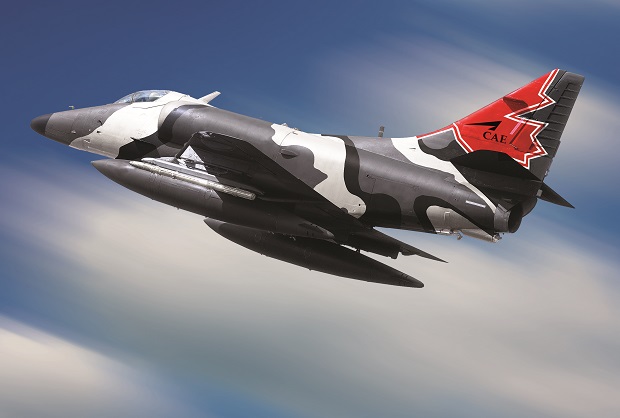CAE Defence and Security Canada has formed a joint venture with tactical aircraft provider Draken International of Lakeland, Fla. In the Canadian company’s bid to deliver the Canadian Armed Forces Contracted Airborne Training Services (CATS).
CATS, which is estimated to be worth between $500 million and $1.5 million, has been operating under interim status for the past 10 years.
The Forces itself originally delivered CATS through the Air Force Combat Support Squadrons but now want to make the program permanent and award a 10-year contract with options for additional two-year and three-year renewals.
The program provides the armed forces with a range of realistic combat training services which include airborne simulation of hostile threats for fighter pilots, airborne support for Forward Air Controller training, simulated threats to naval crews and land forces, targets to training operators of radar, electro-optical and infrared-guided weapons systems, as well as electronic warfare training for aircrews, land forces, aerospace weapons operators and navy frigates.
The deal will include qualified crews, material, facilities, associated maintenance and engineering support and project management.
Companies were initially asked to respond to the request for proposals (RFP) by January 15 this year, but the date was extended to February 16. The government to award a 10-year contract to the successful bidder by the end of 2016.
The CATS for Canada’s Department of National Defence are delivered in locations across Canada, primarily Victoria, British Columbia; Cold Lake, Alberta; Bagotville, Quebec; and Halifax, Nova Scotia.
RELATED CONTENT
CAE to launch a process improvement program
Simulation services contract sign of growth for CAE
The CAE-Draken team will deliver a “comprehensive and world-class service for adversary and threat training, electronic warfare and target towing operations,” according to CAE.
The Canada-based joint-venture company will operate the fleet of aircraft needed for the program and take responsibility for delivering the combat support training services for the Royal Canadian Air Force, Royal Canadian Navy and Canadian Army.
“Our solution leverages CAE’s training systems integration capabilities and NATO Flying Training in Canada experience, and combines this with Draken’s world-leading fleet of adversary fighter aircraft and unmatched aggressor training practices,” said Mike Greenley, vice president and general manager, CAE Canada. “The Canadian Forces need to train against future threat aircraft that cannot be replicated without combining actual live-flying fighter aircraft with simulated enhancements.”
Draken operates one of the world’s largest fleet of privately-owned fighter aircraft. The fleet is made up of 70 former military planes which the company says are configured to replicate capabilities found in modern 4th generation fighter jets. The aircraft are used for various types of military training objectives by air forces around the world.
The CAE-Draken team has proposed a fleet of Douglas A-4 Skyhawk fighter aircraft to support the CATS program. The fleet has had extensive upgrades and now delivers capabilities similar to Canada’s CF-18 fighter aircraft they would be training against, according to CAE.
The team also proposed a comprehensive research and development program aimed at developing the next-generation live-virtual-constructive (LVC) training capabilities for adversary and aggressor air training services.
“We believe our combined offering with CAE has the ability to revolutionize the combat support provided under the Contracted Airborne Training Services program in Canada, as well as an advanced adversary and aggressor air training support globally,” said Jared Isaacman, chief executive officer of Draken International. ”

